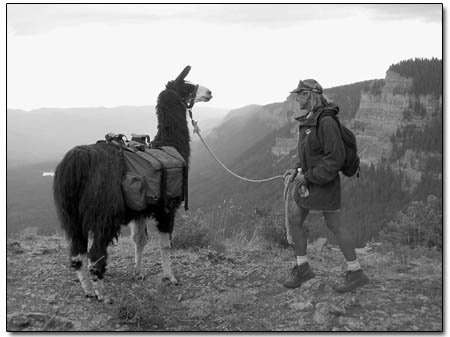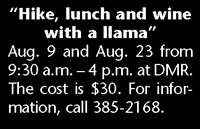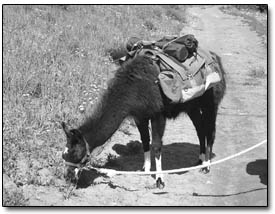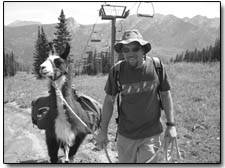| Pack
animals prove worthy companions on and off the trail by Jen Reeder
 |
| Lois Bartig-Small, aka
the “Llama Lady,” coaxes her llama Dreamcatcher
to begin the trek back down the mountain at DMR on
Sunday./Photo by Jennifer Reeder |
The activity’s title said it all and sounded too
good to be true: “Hike, Lunch and Wine with a Llama.”
Since my boyfriend, Bryan, and I bought a house in Durango
West last month, I’d been casually suggesting that
instead of a dog, we get a pet llama. Our  Realtor,
friends and parents gave Bryan sympathetic looks whenever
I would mention my great idea, but he kindly placated
me with “We’ll see.” So the chance to
go hiking, dining and wining with llamas last Sunday seemed
the perfect stepping stone toward making one a pet. Realtor,
friends and parents gave Bryan sympathetic looks whenever
I would mention my great idea, but he kindly placated
me with “We’ll see.” So the chance to
go hiking, dining and wining with llamas last Sunday seemed
the perfect stepping stone toward making one a pet.
The San Juan Mountains Association started sponsoring
Sunday llama treks last year at Durango Mountain Resort,
and last Sunday was this season’s first. Despite
the challenge of rising before noon on a Sunday, Bryan
and I made it to DMR by 9:30 a.m. with water and rain
gear in tow. We met San Juan Mountains Association volunteer
Larry Eads, who would be acting as the naturalist on the
hike. I asked him a question about llamas, and he said
I needed to wait to talk to the hike leader, Lois Bartig-Small,
who was driving the llamas up to the trailhead with her
husband, Ed Small. “We call her the Llama Lady,”
he said with a grin.
So I kept my questions to myself as we rode up Lift 4
on the way to “meet the llamas.” The lift
operator had been full of questions too when she heard
where we were going. “Do you ride the llamas?”
We shouted “no” as we rose up over kids chasing
chipmunks on the put-put golf course. At the top, we met
our fellow hiker, Gail. Being a nondrinker on the Atkins
diet who would be unable to eat the “cracker”
part of the cheese and crackers, Gail admitted she was
there on a fact-finding mission: She had recently bought
llamas.
The small group soon was introduced to Lois and Ed, who
were packing the necessary provisions onto the backs of
Dreamcatcher, a 9-year-old llama, and his 4-year-old son,
Rio. The Llama Lady introduced us to them with one caveat:
They don’t like to have their heads touched. I tried
to swallow my disappointment that I wouldn’t be
able stroke their snouts, and Bryan tried to get over
the names (“As far as I’m concerned, the only
name for a llama is ‘Pepe,’” he’d
said in the car.)
 |
| Rio the llama takes
a break to sample the local vegetation. A relative
of camels, llamas get most of their water from eating
plants. The pack animals, which originate in South
America, have the lifespan of a horse – about
20 years./Photo by Jennifer Reeder |
Lois soon distracted us by talking about the special
traits of her llamas, like their alert natures. Llamas
have different personalities, she said, and some aren’t
too interested in trails or even walking. But we weren’t
to worry. “These two really like to see what’s
around the next bend,” she assured us. Lois went
on to stress the general qualities of llamas that make
them ideal stock animals, such as their soft, two-toed
feet that don’t tear up trails as horses’
hooves do. An added bonus: their scat feces is smaller,
more akin to that of deer. As if on cue, Dreamcatcher
spread his back legs. “He’s going to demonstrate!”
Lois laughed as I took a step back.
This directly led into Lois’ next piece of llama
trivia. Llamas take long pee breaks, so “every time
they stop and take a leak, it’s a good time to eat
something because it’s gonna be awhile,” she
said. Relatives of camels, llamas drink little, retaining
moisture through plants they eat.
At 300 pounds, Dreamcatcher is considered medium-sized
and usually carries 60 to 70 pounds. Lois said larger
llamas can carry up to 100 pounds. I eyed the bags she
strapped to Dreamcatcher’s back, hoping one of them
held an oakey cabernet.
We started on the 3-mile hike to Castlerock, and it was
soon evident how Lois earned her “Llama Lady”
nickname. “They’re strong, like a ballet dancer
with very long legs,” I overheard her gushing to
Gail.
Lois said she developed her love of llamas when, because
of a health problem, she couldn’t carry a heavy
pack. Not wanting to stop hiking, she realized llamas
could be the solution to her problem. She began working
at a local llama boarding and outfitting operation, where
she met Dreamcatcher. She was instantly “hooked”
and eventually bought him.
“They’re great companions, like a cat –
there if you want to spend time with them but independent
and aloof if you don’t,” she said, adding
that some of the bigger training challenges are teaching
them to step over obstacles like logs or water instead
of jumping (“They’re great jumpers!”)
and accepting a saddle and its pack (“They dance
around the first million times.”).
Lois, who has been involved with the San Juan Mountains
Association since it started in 1988 and served as the
group’s president from 1993-98, said the walks are
a great way to introduce people to llamas. Coincidentally,
the walks also are a great way to combine her passion
for the environment and llamas to raise funds for the
group. Lois, who, along with Ed and Larry, volunteers
her time, said the work pays off in other ways. “You
feel so good about contributing to what you have a passion
for,” she said. “The more you give the more
you get back – that’s what makes my summer
go ’round.”
 |
| Bryan Fryklund, possible
future llama owner, tries his hand at guiding Dreamcatcher.
Considered a medium-sized llama, Dreamcatcher can
carry around 70 pounds of gear, wine, brie and crackers./Photo
by Jennifer Reeder. |
As we meandered up the trail, Lois and Ed called to a
group of fast-approaching mountain bikers to slow down.
“There are llamas on the trail!” they warned.
Ed said it can be frustrating when cyclists don’t
know trail etiquette, which gives the right-of-way to
stock animals. Often, it takes a few moments to get the
llamas to the side of the trail, and if cyclists don’t
slow down, it can get ugly. But Ed didn’t fault
the cyclists entirely. “It’s not their fault;
they just haven’t been educated,” he said.
The pause in the action provided Larry a chance to identify
wildflowers, such as wild geranium, parsley, osha and
something called louse wart. “Not something you
want to call your husband or wife,” he chuckled
as Rio and Dreamcatcher munched on the flowers he’d
just identified.
After a few hours, we reached Castlerock, our picnic
spot. We gazed down on Electra Lake and up at the gathering
thunderclouds as Lois, Ed and Larry unpacked brie, red
and white wine, and turkey wraps. The wine went down smoothly
– maybe a little too smoothly – and we found
ourselves laughing instead of packing when we heard discussions
about shutting down the DMR lifts over Lois’ radio:
“Another boomer, dude – definitely closer.”
Thunder began to echo around us, and we donned our rain
gear. Lois said the llamas don’t like lightning
and sometimes hum to soothe themselves. She said they’d
probably “kush down,” and keep their heads
low to the ground as we hiked back to DMR. Perhaps to
alleviate the impending stress, Lois hugged Dreamcatcher
and declared, “I love you” as she loaded him
up. Then she turned unapologetically to us and explained,
“I never had dogs or cats or even kids, and finally
I get in my 50s and I can’t leave a llama alone!”
And she’s not alone. Llamas have become increasingly
popular with baby boomers who don’t want to carry
heavy backpacks anymore, she said. There’s even
a national newsletter for llama owners just like herself.
Like their cousins the alpacas, llamas have their roots
in South America. But whereas alpacas are bred for their
fur, llamas are bred to be pack animals, particularly
the males. A trained male llama fetches $1,500 to $2,000
locally, she said.
The rain never got too heavy, and I led Dreamcatcher
back down the hill as Ed entertained the crowd with the
antics of a crazy friend in Mexico: “Then he started
knocking over furniture 85 the Federales came and didn’t
even knock.”
We made it back to the trailer, and Dreamcatcher had
only hummed a few times. Gail and I brushed him, and then
we all said our goodbyes. As Bryan and I drove back home,
I waited a few minutes and then started bugging him about
a pet llama again. We agreed to revisit it again in 15
years. In the meantime, I know where to find the Llama
Lady.
|

